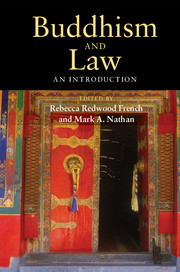Book contents
- Frontmatter
- Dedication
- Contents
- Maps and Illustrations
- Contributors
- Preface
- Abbreviations
- Introducing Buddhism and Law
- Part I The Roots of Buddhism and Law in India
- Part II Buddhism and Law in South and Southeast Asia
- Part III Buddhism and Law in East Asia
- Part IV Buddhism and Law in North Asia and the Himalayan Region
- A Selection of Readings
- Index
- References
Introducing Buddhism and Law
Published online by Cambridge University Press: 05 August 2014
- Frontmatter
- Dedication
- Contents
- Maps and Illustrations
- Contributors
- Preface
- Abbreviations
- Introducing Buddhism and Law
- Part I The Roots of Buddhism and Law in India
- Part II Buddhism and Law in South and Southeast Asia
- Part III Buddhism and Law in East Asia
- Part IV Buddhism and Law in North Asia and the Himalayan Region
- A Selection of Readings
- Index
- References
Summary
Some edited volumes are self-explanatory and others need a substantial introduction to the material; the latter is the case with this volume. While the title is intriguing, many readers will need a guidebook to explain much of what they are encountering here. And it is well worth the effort as the material is some of the most exciting and unorthodox both on legal systems and in Buddhist Studies. Therefore, the task of this introduction to the volume is to provide readers with a road map to define the object of study, and to offer ways to think about the field of Buddhism and Law.
This introduction is divided into three main sections: Buddhism, Law, and Buddhism and Law. The first, Buddhism, presents a brief account of the life of the Buddha before turning to an examination of dharma, a fundamental term in Buddhism that has long been translated as law. A discussion of Buddhist monasticism and some of the misconceptions that have surrounded the place of the monastic community in society comes next, followed by a consideration of the Vinaya, the canonical Buddhist law codes that have served to regulate the religious life of Buddhist monasteries. Buddhist traditions also possess a wealth of other legal texts and materials, most of which reflect attempts to devise supplementary rules and regulations that fit local conditions, and these are introduced last.
- Type
- Chapter
- Information
- Buddhism and LawAn Introduction, pp. 1 - 28Publisher: Cambridge University PressPrint publication year: 2014
References
- 2
- Cited by



